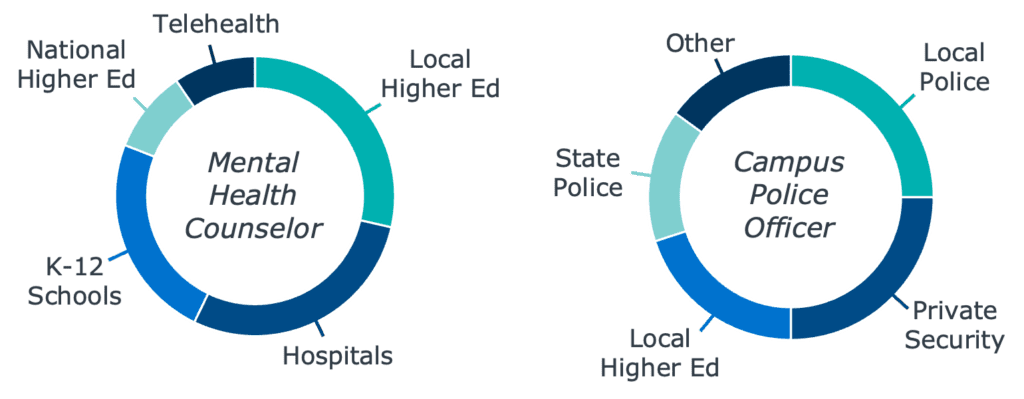5 mistakes to avoid when determining your higher ed institution’s competitors for staff talent
February 1, 2024, By Natalie Ken, Research Analyst
Colleges and universities are competing with a more diverse set of competitors for talented staff than ever before due to a tight labor market and practices like remote work, which allow employers to tap different talent pools. Yet most cabinet and HR leaders lack a shared understanding of their institution’s competitors for staff talent—or how to go about diagnosing it.
Without a clear understanding of their competitors, cabinets and HR teams struggle to accurately assess their current market position. Moreover, they often end up under- or over-investing in certain talent strategies (e.g., posting on costly and ineffective job boards), thereby wasting limited resources and ultimately reducing the ROI on staff recruitment and retention.
Through our conversations with dozens of campus leaders, we identified five common pitfalls to avoid when determining your institution’s new competitive set for staff talent. Read on to learn the pitfalls and how to more accurately diagnose talent competitors.
Pitfall #1: Assuming your institution’s competitive sets for staff talent and student enrollment are the same
Most campus leadership teams have a list of peer or aspirant institutions they compete with for students. This is usually based on enrollment-centric criteria like institutional classification, student body size, or athletic conference. Yet, many institutions use these same lists and criteria when determining their competitors for staff talent—even though most staff do not make employment decisions based on these factors.
Your competitive set for enrollment differs from your competitive set for talent in a few ways:
- Only includes higher ed competitors, no out-of-sector employers
- Prioritizes organizational attributes that are not relevant for staff (e.g., athletic conference)
- Overlooks labor market trends and criteria that impact staff choices
Instead, cabinet and HR leaders need to invest in diagnosing a separate competitive set for staff talent using criteria that staff (not students) value. For example, staff tend to value factors like remote work policies and employer-provided benefits.
Pitfall #2: Only including other colleges and universities in your institution’s competitive set for staff talent
Historically, institutions mostly competed with higher ed peers for talented staff. But today, colleges and universities are competing head-to-head with more out-of-sector employers. In fact, 61% of higher ed staff indicate they are open to roles at private for-profit companies.
These out-of-sector employers are attracting higher ed talent by eliminating geographic barriers via remote work options and hiring based on skills rather than stringent degree requirements. Additionally, they are strengthening their value propositions through better pay and new benefits like student loan repayment assistance. This means that colleges and universities’ competitive sets for staff talent are bigger and more diverse than ever before.
As a result, campus and HR leaders must update their competitive set so that it does not just include traditional higher ed competitors, but also employers in other industries that are seeking to attract and retain the same talent as colleges and universities.
Pitfall #3: Using a single competitive set for all staff talent
Many institutions aim to identify a single list of all competitors for staff talent. While this would certainly make things simpler, the reality is that institutions compete with different employers depending on the functional area and role.
For example, an institution might compete primarily with hospitals, K-12 schools, and local institutions for mental health counselors but compete mostly with local police and private security firms for campus police officers.
Representative examples of roles with differing proportions of in- and out-of-sector competitors

Cabinet and HR leadership teams therefore must invest time and capacity in diagnosing their institution’s multiple competitive sets for staff talent. When prioritizing which distinct competitive sets to diagnose first, leaders should focus on those for functional areas and/or roles that have experienced extensive changes in competitors and competition levels.
Pitfall #4: Overlooking the most important data for identifying competitors for staff talent
The most straightforward way to determine your institution’s top competitors is to look at where your campus wins and loses staff talent. But most institutions aren’t using this information to pinpoint their top competitors, instead often over-relying on one-off anecdotes or gut instinct.
The good news is HR teams can and should tap into a wider array of commonly overlooked data sources for pinpointing competitors, many of which they already have access to. These sources include applicant tracking systems, employee stories, exit interviews, LinkedIn, job boards, and labor market data.
Pitfall #5: Rarely updating your institution’s competitive sets for staff talent
An institution’s competitive set for student enrollment is quite stable and insulated from market fluctuations. In contrast, their competitive sets for staff talent are highly susceptible to labor market pressures like labor shortages, unemployment trends, new entrants, or wage growth.
This means cabinet and HR leaders must reassess their institution’s competitors for staff talent at least every two to three years. While this admittedly requires a big time and capacity investment, it is crucial for accurately assessing market position and making smart decisions about talent investments and strategy.

More Blogs

How to avoid 3 common salary study mistakes in higher ed

How to target higher ed salary investments to bolster recruitment and retention
